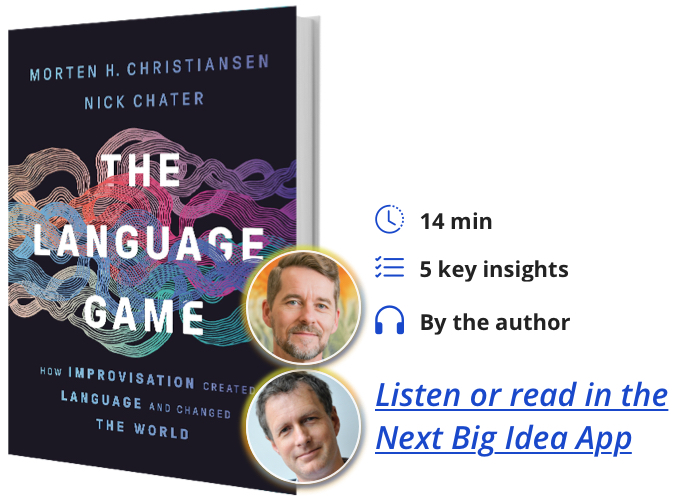Morten H. Christiansen is the William R. Kenan, Jr. professor of psychology at Cornell University as well as a senior scientist at the Haskins Labs and professor in cognitive science of language at the School of Communication and Culture, Aarhus University, Denmark. He is the author of more than 200 scientific papers and has edited four books. Nick Chater is a cognitive psychologist who is a professor of behavioral science at Warwick University and has held chairs in psychology at Warwick and at University College London. He has won four national awards for psychological research, and has served as associate editor for the journals Cognitive Science, Psychological Review, and Psychological Science.
Below, Morten and Nick share 5 key insights from their new book, The Language Game: How Improvisation Created Language and Changed the World. Listen to the audio version—read by Morten and Nick themselves—in the Next Big Idea App.

1. Language is fundamentally improvised communication.
We’ve all been thinking about language the wrong way—as a type of fixed code allowing us to bottle our thoughts into a stream of words, to be uncorked and decoded by the listener. Instead, in language, as in charades, we communicate as best we can by hints and clues that are created and understood (if at all) through the powers of human ingenuity.
It is tempting to see words as mere containers that package and transmit thoughts, feelings, and ideas from one mind to another. This view of communication has even influenced how we talk about language. We say “your words are hollow,” “I can’t cram my idea into a single sentence,” or “try to put your feelings into words.” But meaning is not transmitted like a message in a bottle—it is created collaboratively, and in the moment, by the participants in a conversation. The words that we utter are no more than clues to our intended meaning. To understand each other, we need to piece together the best interpretation we can based on these linguistic clues, together with everything else we know about the world, about each other, and about what we have said already. This constructive process is at the heart of how language works.
The incredible flexibility of language comes from the creativity of our charade-playing, and our ability to make ingenious, metaphorical leaps to figure out what is being conveyed. The playfulness, nuance, and subtlety of language isn’t an “add-on”—it is its very core. Language is, in a very real sense, poetry first and prose second.
Thinking of language as charades has real-life implications, too. It helps explain why face-to-face interactions are often so crucial for successful cooperation; why email correspondence can easily go awry; and why tweets can so often fail to inform, and can often divide us. Communication is not about lobbing messages at each other, shouting more loudly if we are not understood. Like charades, it is a matter of creative, interactive improvisation.
2. The meaning of words is strange and slippery.
Most of us have some pretty strong views about words. We tend to think that each word has a true meaning that is spelled out in the dictionary, and that using a word in a way that deviates from that meaning is not only just plain wrong, but often rather annoying. Indeed, everyday uses of literally, pathetic, and awesome can be something of a torment for the language “purists.” And more seriously, disputes over how we define men and women, what counts as marriage, or what words we use to describe ethnicity have become contentious, and ever shifting, battlegrounds.
“Dictionaries don’t really contain definitions at all—they are no more than lists of helpful clues and examples.”
Yet word meanings aren’t what they seem. When we look closely at language, we find that words don’t have stable meanings at all. Consider the everyday adjective light. Things we describe as light include: a morning, a room, a play, a piece of music, a package, an aircraft, a machine gun, an infantry battalion, a meal, a shade of red, a beer… the list seems endless. But these meanings are linked only by a network of loose, often metaphorical, connections—“light” things have no common essence. But what about dictionary “definitions”? Well, it turns out that, when we look closely, we find that dictionaries don’t really contain definitions at all—they are no more than lists of helpful clues and examples.
The shape-shifting nature of meaning often goes unnoticed. When we open a door, a “door” is a solid object; but when we walk through a door, that “door” very definitely is not. Words don’t have essences, but are merely clues to meaning. And they get their meaning from the context in which we use them, just like gestures in a game of charades. We need to embrace the continual change of word meanings as they shift with the times—their fluidity is not a flaw to be eliminated, but the secret of their power.
3. The rules of English were never decreed—they evolved, and they continue to do so.
Each charade can build on the last—we reuse, simplify, and modify our successful past charades to get our next message across. A charade for King Kong may be reworked for gorillas, or primates in general—or even as part of a charade for the Empire State Building. And, over time, our linguistic charades become increasingly entrenched through repetition. Yet they are always being reused and recombined in new and creative ways.
This should help allay the worry that English is in decline through weakness in the teaching of grammar, looseness in the use of words, or the supposedly malign impact of texting and social media. Indeed, fears of the decline of English are hardly new—tracing back to Jonathan Swift and even a 14th-century monk. So why doesn’t English now lie in ruins?
The explanation is the remarkable phenomenon of spontaneous order, most popularly associated with ideas about self-organization in economies and in nature, from snowflakes to the biology of life itself. The orderly patterns in language don’t arise through the efforts of any “central planner,” but through the cumulative impact of our countless conversations over many generations. And each new creative, charade-playing innovation does not erode existing patterns, but rather creates new patterns through the continual invention of new words, creative reuse and recombination of old words, and the endless re-forming of grammatical rules.
“Languages, like economies and living organisms, are continually, globally reorganizing through myriad local changes.”
The rules of English were never decreed—they evolved, and they continue to do so. Consider the word like, whose grammatical role has shifted to allow informal English to include, “She was like, ‘no way!’” But linguists have found that this new role for like is by no means the harbinger of linguistic chaos. Instead, it follows its own grammatical rules, and meshes in complex ways with the rest of the language. Indeed, like is following an age-old pattern of linguistic change, including the gradual “bleaching” of meaning (in the new usage, like is not about “liking” things or people anymore).
Languages, like economies and living organisms, are continually, globally reorganizing through myriad local changes. So we should not worry about our kids’ language, or whether texting and emojis will ruin it—linguistic innovation is just part of the normal and continuous process by which language evolves.
4. Language is the product of cultural evolution, and is not based on a “language instinct” somehow wired into our genes and brains.
As every parent knows, children pick up language incredibly quickly. This has led notable thinkers like Noam Chomsky and Steven Pinker to suggest that children must have a built-in genetic blueprint for language. But nothing could be further from the truth: language is all about culture, not biology.
Language is a communicative tool shaped by our brains, just as physical tools like scissors have been perfectly shaped by cultural evolution to fit our hands, and to be easy to use. Awkward cutting tools will rapidly be abandoned; only the ergonomic will survive. And the same goes for language.
It turns out that insights from the economist and Nobel laureate Thomas Schelling about cultural “focal points” can help show how our linguistic abilities are grounded in social conventions, built up over generations and shaped to be as learnable as possible. When children learn language, they only need to follow in the footsteps of past generations of language learners—who are, of course, just like themselves, with the same brains and cultural background. Children therefore make the right guesses about how language works because they make the same guesses as previous generations of language learners.
“Children therefore make the right guesses about how language works because they make the same guesses as previous generations of language learners.”
So language is not built-in from birth—on the contrary, learning and interaction is crucial. The latest research finds that to become competent language users, children need a lot of experience interacting with others using language. This means that helping kids improve their language skills is not a matter of giving them more words, as children are not empty vessels to be filled with vocabulary. Instead, the key to helping kids learn language is to engage them in conversation, play, and story-time.
5. The nature of language tells us something important about ourselves.
Viewing language through the lens of linguistic charades, we can see that language is fundamentally collaborative—and that, as its creators, humans are a profoundly collaborative species.
Indeed, our collaborative charade-playing abilities may turn out to be the key to why we humans have evolved such large brains. Specifically, the ability to utilize an ever-growing set of linguistic clues, in ever more creative ways, may have resulted in a virtuous circle. More sophisticated charades allows increasingly rich communication and greater social complexity. But this, in turn, increases the selective pressure for bigger brains—and only the smart will prosper in a complex social environment. Bigger brains will enable yet more advanced charade-playing, selecting for bigger brains still, and so on. How humans got onto this virtuous circle is lost in the mists of time, but it seems clear that our nearest primate cousins did not join us. This helps explain why we have language, and other apes do not. Apes are simply not able to play charades.
The human ability to create language changes everything. It allows us to pass on knowledge and skills, rather than being condemned to relearn everything afresh in each generation. It allows us to create the complex webs of agreements that bind society together, and helps create the moral and religious norms to help us coordinate our actions with others. Without language there could be no legal system, no organized trade or finance, no politics, and no cumulative science or technology. Language is humanity’s greatest invention, without which our other spectacular achievements would be inconceivable.
Yet all we ever do is play linguistic charades “in the moment”—to get our immediate message across. There has never been any “plan” to create a system for communication that might revolutionize human life—but each charade shapes the next in remarkable and unexpected ways. Our greatest invention is the cumulative, but accidental, result of the momentary communicative efforts of countless past generations. The story of language is thus the story of humanity itself.
To listen to the audio version read by co-authors Morten H. Christiansen and Nick Chater, download the Next Big Idea App today:































